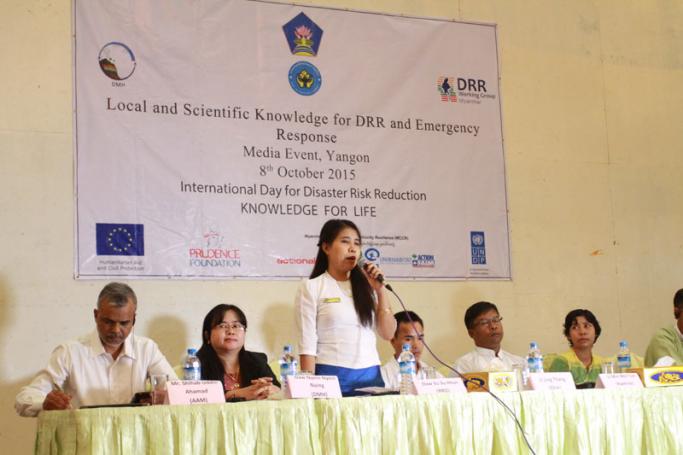The Disaster Risk Reduction Working Group, supported by the Myanmar Consortium for Community Resilience and UNDP, held a press conference to draw attention to ways of predicting and averting the negative effects of disasters in Myanmar.
The event “Local and Scientific Knowledge for Disaster Risk Reduction and Emergency Response” on October 8 brought together community leaders from the Ayeyarwaddy Region and the Rakhine and Chin States with representatives from government and the International NGO community.
Community leaders on the panel highlighted the importance of traditional weather forecasting methods, which have often been passed down through generations – in helping communities predict seasonal rainfall and prepare for periods of drought or potential flooding.
“If birds don’t nest at the top of the trees, the weather is not going to be that bad, that’s one thing to notice,” said U Aung Myo Naing from Kyaintalee Township in southern Rakhine State.
“Another example is if birds don’t arrive on time then the rain is going to last longer,” he said.
As ActionAid Country Director Mr Shihab Uddin Ahamad pointed out, communities’ traditional knowledge of the weather and the local environment where they live remains important, despite the advances made in science and technology. He gave the example of the Moken people’s role in preventing deaths during the devastating Indian Ocean tsunami of 2004.
The Moken people are a small nomadic indigenous group living in Myanmar’s southern Tanintharyi Region and Thailand’s southern region. They are known for their free-diving techniques and are commonly referred to as “sea gypsies.”
“It was the Moken people who alerted tourists and locals to the changing tide of the ocean, and because of this hundreds of lives were saved,” said Mr Ahamad, referring to the call they made to people to run inland and seek higher ground prior to the high waves rushing in.
Disaster risk reduction and emergency response has received a lot of publicity after the “Save Myanmar” campaign kicked off after the recent damage done by Cyclone Komen.
Widespread landslides and flooding in Chin State crippled and cut the region off from emergency aid relief in August after Cyclone Komen swept across the Rakhine and Chin States. Heavy rains also led to excessive flooding in Kalay in western Sagaing Region.
“Chin was relatively stable, but now it is one of the most affected places,” U Ling Thang told the meeting. “Swallows flying high and consistent rain offered an alert to people as to what could happen.”
Flooding around the country affected mainly those in poor and rural areas relying on the land for farming. Millions were displaced and had their livelihoods ruined as the government and NGOs scrambled to reduce the long-term effects.
Myanmar – no stranger to natural disasters – will join the International Day for Disaster Reduction (IDDR) 2015 activities on October 13, with events to be held around the country, including in Nay Pyi Taw.
Myanmar still largely lacks the infrastructure to effectively inform citizens about natural disasters or provide timely warnings on approaching hazards. This is despite a number of foreign governments supplying equipment for weather stations, with around 100 currently operating around the country, Daw Nyein Nyein Naing told the conference.
Daw Nyein Nyein Naing, Assistant Director with the Department of Meteorology and Hydrology, spoke of the major technological improvements that have been made in the field of hazard monitoring and early warning in Myanmar since Cyclone Nargis struck in 2008.
“The Department of Meteorology and Hydrology are trying their best and put their focus on high risk areas in order to prevent [or mitigate the negative effects of] disasters,” said Daw Nyein Nyein Naing at the conference.
You are viewing the old site.
Please update your bookmark to https://eng.mizzima.com.
Mizzima Weekly Magazine Issue...
14 December 2023
Spring Revolution Daily News f...
13 December 2023
New UK Burma sanctions welcome...
13 December 2023
Spring Revolution Daily News f...
12 December 2023
Spring Revolution Daily News f...
11 December 2023
Spring Revolution Daily News f...
08 December 2023
Spring Revolution Daily News f...
07 December 2023
Diaspora journalists increasin...
07 December 2023
More than 70,000 IDPs return home after fighting stops in Rakhine












